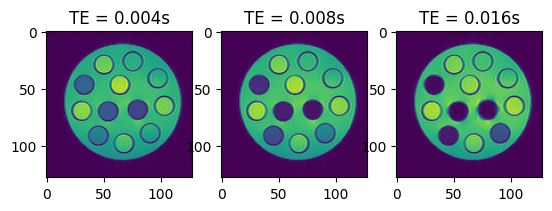QMRI Challenge ISMRM 2024 - \(T_2^*\) mapping
# Imports
import shutil
import tempfile
import time
import zipfile
from pathlib import Path
import matplotlib.pyplot as plt
import torch
import zenodo_get
from mpl_toolkits.axes_grid1 import make_axes_locatable # type: ignore [import-untyped]
from mrpro.algorithms.optimizers import adam
from mrpro.data import IData
from mrpro.operators.functionals import MSE
from mrpro.operators.models import MonoExponentialDecay
Overview
The dataset consists of gradient echo images obtained at 11 different echo times, each saved in a separate DICOM file. In order to obtain a \(T_2^*\) map, we are going to:
download the data from Zenodo
read in the DICOM files (one for each echo time) and combine them in an IData object
define a signal model (mono-exponential decay) and data loss (mean-squared error) function
carry out a fit using ADAM from PyTorch
Everything is based on PyTorch, and therefore we can run the code either on the CPU or GPU. Simply set the flag below to True to run the parameter estimation on the GPU.
flag_use_cuda = False
Get data from Zenodo
data_folder = Path(tempfile.mkdtemp())
dataset = '10868361'
zenodo_get.zenodo_get([dataset, '-r', 5, '-o', data_folder]) # r: retries
with zipfile.ZipFile(data_folder / Path('T2star.zip'), 'r') as zip_ref:
zip_ref.extractall(data_folder)
Title: Quantitative Study Group: T_2^*
Keywords:
Publication date: 2024-03-25
DOI: 10.5281/zenodo.10868361
Total size: 445.8 kB
Link: https://zenodo.org/records/10868361/files/T2star.zip size: 445.8 kB
Checksum is correct. (f387357a0b4024ca62e979203eff9def)
All files have been downloaded.
Create image data (IData) object with different echo times
te_dicom_files = data_folder.glob('**/*.dcm')
idata_multi_te = IData.from_dicom_files(te_dicom_files)
# scaling the signal down to make the optimization easier
idata_multi_te.data[...] = idata_multi_te.data / 1500
# Move the data to the GPU
if flag_use_cuda:
idata_multi_te = idata_multi_te.cuda()
if idata_multi_te.header.te is None:
raise ValueError('Echo times need to be defined in the DICOM files.')
# Let's have a look at some of the images
fig, axes = plt.subplots(1, 3, squeeze=False)
for idx, ax in enumerate(axes.flatten()):
ax.imshow(torch.abs(idata_multi_te.data[idx, 0, 0, :, :]).cpu())
ax.set_title(f'TE = {idata_multi_te.header.te[idx]:.3f}s')

Signal model and loss function
We use the model \(q\)
\(q(TE) = M_0 e^{-TE/T_2^*}\)
with the equilibrium magnetization \(M_0\), the echo time \(TE\), and \(T_2^*\)
model = MonoExponentialDecay(decay_time=idata_multi_te.header.te)
As a loss function for the optimizer, we calculate the mean-squared error between the image data \(x\) and our signal model \(q\).
mse = MSE(idata_multi_te.data)
Now we can simply combine the two into a functional which will then solve
\( \min_{M_0, T_2^*} ||q(M_0, T_2^*, TE) - x||_2^2\)
functional = mse @ model
Carry out fit
# The shortest echo time is a good approximation of the equilibrium magnetization
m0_start = torch.abs(idata_multi_te.data[torch.argmin(idata_multi_te.header.te), ...])
# 20 ms as a starting value for T2*
t2star_start = torch.ones(m0_start.shape, dtype=torch.float32, device=m0_start.device) * 20e-3
# Hyperparameters for optimizer
max_iter = 20000
lr = 1e-3
if flag_use_cuda:
functional.cuda()
# Run optimization
start_time = time.time()
params_result = adam(functional, [m0_start, t2star_start], max_iter=max_iter, lr=lr)
print(f'Optimization took {time.time() - start_time}s')
m0, t2star = (p.detach() for p in params_result)
m0[torch.isnan(t2star)] = 0
t2star[torch.isnan(t2star)] = 0
Optimization took 44.555574893951416s
Visualize the final results
To get an impression of how well the fit has worked, we are going to calculate the relative error between
\(E_{relative} = \sum_{TE}\frac{|(q(M_0, T_2^*, TE) - x)|}{|x|}\)
on a voxel-by-voxel basis.
img_mult_te_abs_sum = torch.sum(torch.abs(idata_multi_te.data), dim=0)
relative_absolute_error = torch.sum(torch.abs(model(m0, t2star)[0] - idata_multi_te.data), dim=0) / (
img_mult_te_abs_sum + 1e-9
)
fig, axes = plt.subplots(1, 3, figsize=(10, 2), squeeze=False)
colorbar_ax = [make_axes_locatable(ax).append_axes('right', size='5%', pad=0.05) for ax in axes[0, :]]
im = axes[0, 0].imshow(m0[0, 0, ...].cpu())
axes[0, 0].set_title('$M_0$')
fig.colorbar(im, cax=colorbar_ax[0])
im = axes[0, 1].imshow(t2star[0, 0, ...].cpu(), vmin=0, vmax=5)
axes[0, 1].set_title('$T_2^*$')
fig.colorbar(im, cax=colorbar_ax[1], label='s')
im = axes[0, 2].imshow(relative_absolute_error[0, 0, ...].cpu(), vmin=0, vmax=0.1)
axes[0, 2].set_title('Relative error')
fig.colorbar(im, cax=colorbar_ax[2])
<matplotlib.colorbar.Colorbar at 0x7f39e72bf8d0>

# Clean-up by removing temporary directory
shutil.rmtree(data_folder)
